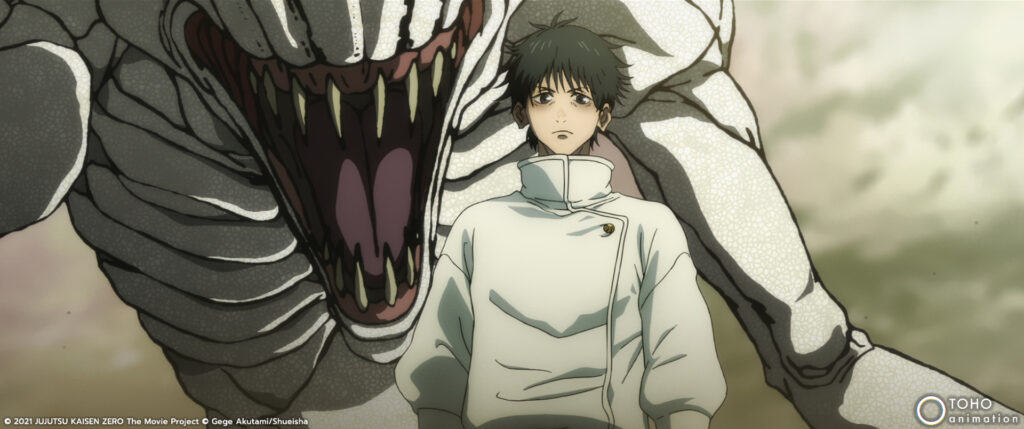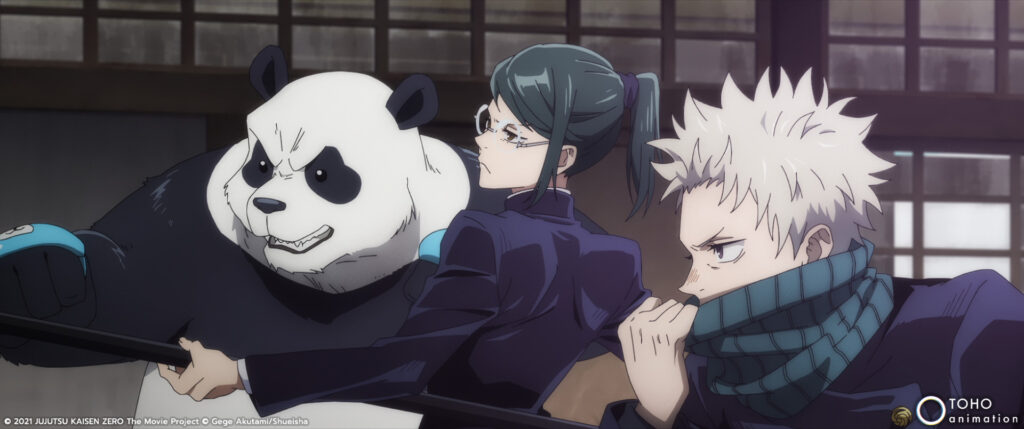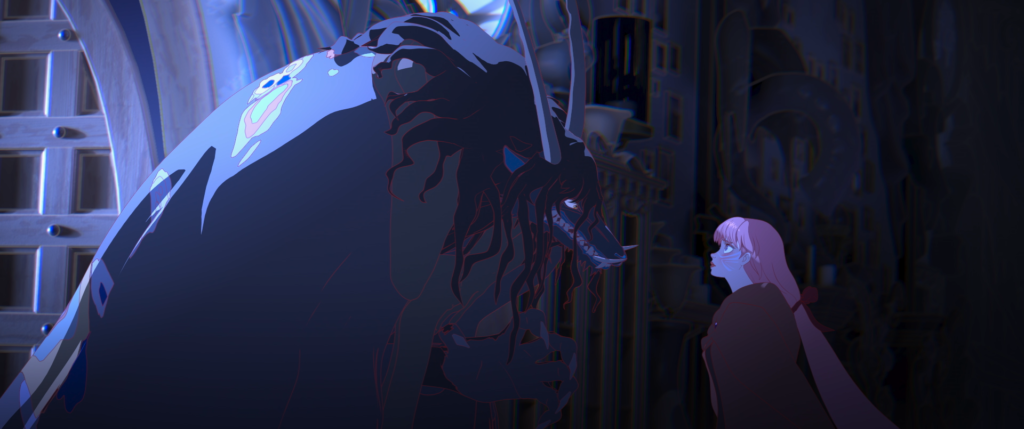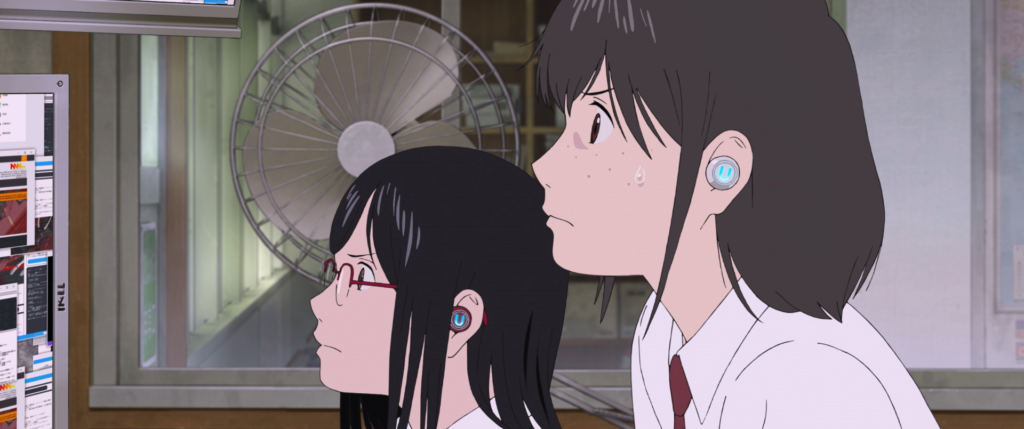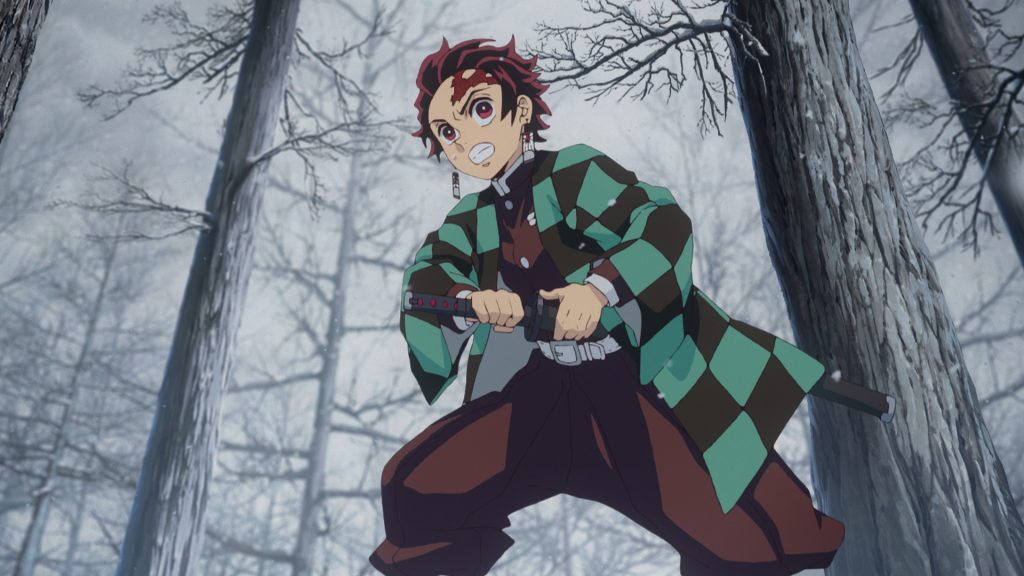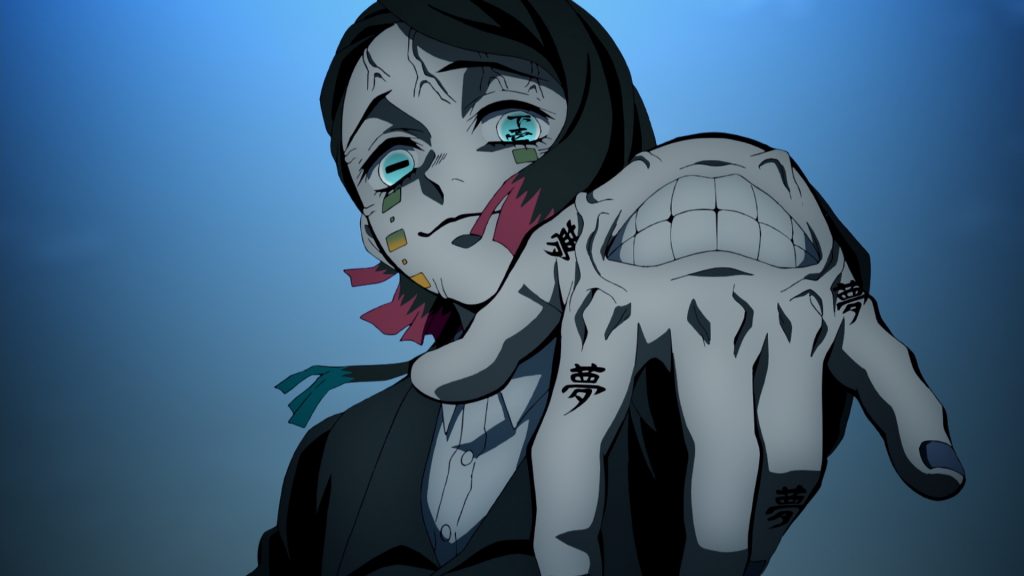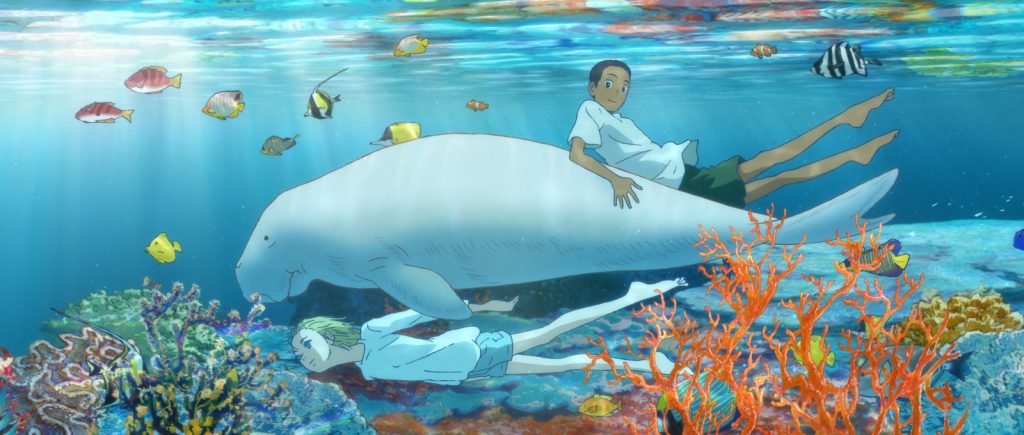June 25, 2022
by Carla Hay
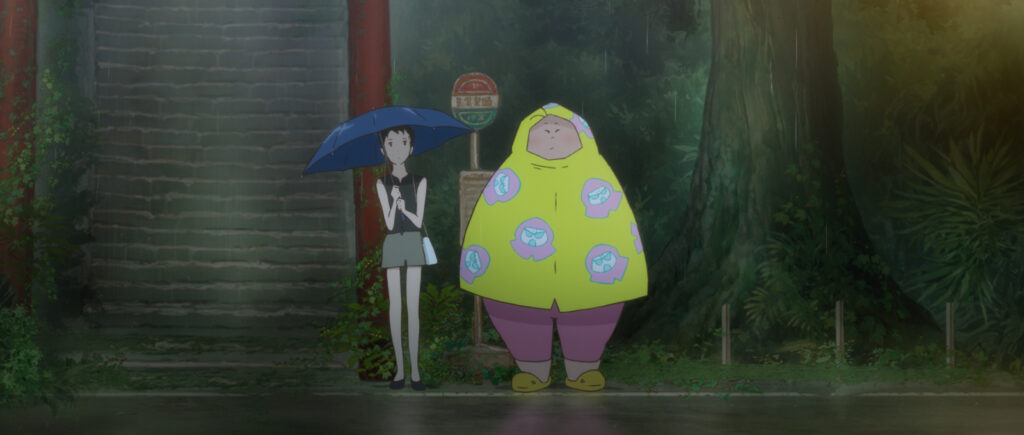
Directed by Ayumu Watanabe
Japanese with subtitles
Culture Representation: The Japanese animated film “Fortune Favors Lady Nikuko,” which takes place primarily in an unnamed village in Japan, tells the story of an unlucky-in-love single mother named Nikuko and her teenage daughter Kikuko, with a cast of characters representing the working-class and middle-class.
Culture Clash: Kikuko is somewhat of an outsider at her school, where she pines over a boy she has a crush on, she longs to be accepted by a clique of popular girls, and she is often embarrassed by her mother’s goofy and larger-than-life personality.
Culture Audience: “Fortune Favors Lady Nikuko” will appeal primarily to people who are interested in anime films about family love and the true meaning friendship.

“Fortune Favors Lady Nikuko” tells a moderately entertaining story about an eccentric single mother and her teenage daughter, who is the story’s narrator. This comedy/drama anime film isn’t great though. It has some problematic mocking of the title character’s large body. The movie’s title is a little misleading because Nikuko (the mother character, voiced by Shinobu Ôtake) isn’t in the film as much as you might think a title character would be. The story is really about Nikuko’s daughter Kikuko (voiced by Cocomi), who is Nikuko’s only child. The movie spends a lot of time on Kikuko’s social interactions with Kikuko’s peers.
Directed by Ayumu Watanabe, “Fortune Favors Lady Nikuko” is based on Kanako Nishi’s 2014 novel of the same name. The novel was also made into a manga series. Satomi Ohshima wrote the “Fortune Favors Lady Nikuko” movie screenplay. The movie’s animation and performances from the voice actors are perfectly fine. The screenplay is where “Fortune Favors Lady Nikuko” falters the most.
The beginning of “Fortune Favors Lady Nikuko” has a montage, with voiceover narration from Kikuko (who’s about 14 or 15 years old), explaining some of Nikuko’s background. Nikuko has a pattern of choosing love partners who are liars, cheaters and con men. These loser boyfriends break Nikuko’s heart and often drain her of her money.
Every time Nikuko has one of these bad breakups, she then moves to another city in Japan, as if she wants to start a new life and try to put her heartbreak behind her. It’s mentioned that Nikuko grew up in an unnamed small town. She moved to Osaka at age 16, and then Nagoya at age 27, and then Yokohana at age 30, and then Tokyo at age 33. And now, at age 35, Nikuko has moved with Kikuko (whom she calls Kukurin as a nickname) to an unnamed small city in Japan.
Nikuko and Kikuko live on a small fishing houseboat owned by Nikuko’s friendly boss Sassan (played by Ikuji Nakamura), who also owns a restaurant/bar called Uwogashi Grill House. Nikuko, who works as a server at Uwogashi Grill House, has had working-class jobs all of her life. She was working at another bar where she met one of her swindler ex-boyfriends. Nikuko doesn’t like to discuss who Kikuko’s father is, so Kikuko has gone through life not knowing anything about her father.
All of Nikuko’s relocations and romantic disappointments have left her “tired,” according to Kikuko. Despite being unlucky in love and experiencing a lot of betrayal, Nikuko has a jolly and exuberant personality. She’s very friendly to strangers, but she doesn’t have many friends. It’s an indication that underneath her extroverted persona, Nikuko is hiding a lot of loneliness and emotional pain.
However, Nikuko gets her greatest joy from being a mother. Kikuko and Nikuko love each other very much, but Kikuko is in that teenage stage of life where Kikuko wants more independence. Nikuko has her share of quirks. As Kikuko explains in the movie’s introduction, Nikuko likes to make puns about numbers and kanji. Nikuko also has an almost juvenile outlook on life, because she likes to make childlike jokes with people. By contrast, Kikuko is serious-minded and introverted.
Nikuko is also the type of person who’s impossible not to notice in a room, because she often talks loudly and can be clumsy. Nikuko also occasionally gets drunk in public. When she gets drunk, she becomes even louder and goofier. And when a parent acts this way, you know what that means for a child, especially if that child is a teenager: That parent is often an embarrassment to the child.
The beginning of “Fortune Favors Lady Nikuko” somewhat oddly lists Nikuko’s measurements, which seems redundant because people watching the movie can already see that she’s a large-sized woman, in terms of her weight proportion to her body. But for anyone who cares, Nikuko’s measurements are listed as being 151 centimeters tall (which is nearly 5 feet tall) and weighing 67.4 kilograms (or about 148 pounds). One of the movie’s flaws is that it seems fixated on Nikuko’s body size as a way to explain why Nikuko is a social misfit.
It’s not really body shaming, but several times throughout the movie, Nikuko’s body size and eating habits are used for slapstick jokes. She often falls down or gets into physically uncomfortable predicaments because of her weight. There are also multiple scenes of Nikuko devouring large quantities of food, because the filmmakers obviously intended viewers to laugh at Nikuko when she eats.
The movie also has some unnecessary and tacky scenes of Nikuko farting or burping. No one watching this movie needs to know how Nikuko’s digestive system is processing gas, but there it is in unavoidable scenes in “Fortune Favors Lady Nikuko.” The movie also hints that Nikuko might have sleep apnea, based on the way she loudly snores and seems to have some difficulty breathing when she sleeps. Any health issues that Nikuko might have are treated as jokes—and this mockery is the movie’s biggest failing.
Nikuko’s physicality is used as the movie’s “comic relief,” but it’s not the movie’s main story. Most of “Fortune Favors Lady Nikuko” is about Kikuko’s angst over her social situation at her school. This not-very-original teen storyline has Kikuko wanting to be liked by a clique of popular girls, led by a snob named Mori.
Kikuko has a schoolmate named Maria (voiced by Izumi Ishii), who was Kikuko’s closest friend at school. However, Maria has been shunned by Mori and her clique, just because they think Maria isn’t cool enough to hang out with them. Because Kikuko wants to be accepted by Mori’s clique, Kikuko has recently been snubbing Maria too. Kikuko says in a voiceover about her social life at school: “When I transferred here, Maria was the first one to talk to me.” And now, Kikuko says she doubts that Maria will ever talk to her again.
Kikuko, who has a tomboyish appearance, is also insecure about how she looks. She has a secret crush on a schoolmate named Ninomiya (voiced by Natsuki Hanae), who is somewhat of a loner and has a reputation for being a little rebellious. Ninomiya, a shaggy-haired teen who has long bangs that almost cover his eyes, seems to know what Kikuko has a crush on him because he notices that she often stares at him.
One day at school, when Ninomiya and Kikuko are talking with each other, he praises Maria for “dressing like a princess and looking feminine.” This comment makes Kikuko jealous, so she tells Ninomiya that Maria had a plan to be the center of attention, and it backfired. Kikuko tells Ninomiya it’s the reason why Mori’s clique has made Maria an outcast.
It’s a catty side to Kikuko that makes her look small-minded and petty. When Ninomiya points out that Maria and Kikuko used to be close friends, Kikuko has to come to terms with how she also played a role in enabling bullying and making Maria feel excluded. The movie shows how Kikuko then handles this reckoning.
Meanwhile, the movie continues with scenarios that show Kikuko being embarrassed by Nikuko. They take a mother-daughter trip to an aquarium. You can easily predict what happens when Nikuko encounters a wet floor.
And then, there’s a School Sports Day at Kikuko’s school, where students and their parents compete against each other in athletic competitions. You can also easily guess what that means for Nikuko and Kikuko. Ninomiya will be watching whatever ends up happening, which adds to Kikuko’s anxiety about this event.
“Fortune Favors Lady Nikuko” has a lot of slapstick comedy, but the movie takes a sharp turn into serious drama when a secret is revealed in the last third of the film. It’s here where “Fortune Favors Lady Nikuko” somewhat redeems itself in how it portrays Nikuko, who no longer becomes a caricature in this part of the movie. How this secret is revealed puts Nikuko in a different context than just embarrassing herself and Kikuko in a buffoonish way.
The reveal of this secret is meant to add more depth to the story, but it comes so late in the movie, some viewers might perceive it as a manipulative plot twist. Other viewers might be emotionally moved by this secret, while some viewers might even shed some tears over it. After the secret is revealed, it brings up some questions that the movie never answers. Even with all of its shortcomings, “Fortune Favors Lady Nikuko” has a meaningful message about family love and true friendships, but viewers have to watch a lot of the movie’s cliché-driven scenarios before it finally gets to this message.
GKIDS released “Fortune Favors Lady Nikuko” in select U.S. cinemas on June 3, 2022, with a sneak preview on June 2, 2022. The movie is set for release on digital, VOD, Blu-ray and DVD on July 19, 2022. “Fortune Favors Lady Nikuko” was originally released in Japan in 2021.

